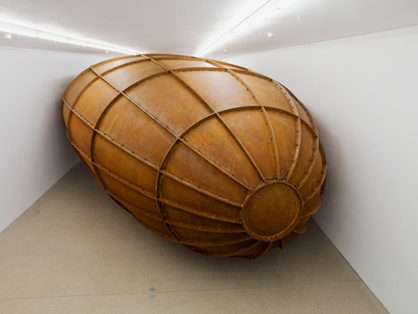Anish Kapoor: Memory
Texto por Susanne Junker
Berlin, Alemania
19.12.08
Exhibition at the Deutsche Guggenheim / Berlin until 1.2.2009
A white crate with a huge rotten egg? Perhaps a technoid and rather archaic balloon? A whale that has got lost in space and time and is now stranded in the heart of the city?
As a commission on behalf of Deutsche Guggenheim in Berlin 1991 Turner Prize winner Anish Kapoor has created a sculpture made of Corten steel which, with a shell that is only 8 mm thick and with dimensions of 14.5 x 8.97 x 4.48 m, fills the approx. 500 m2 area of the Unter den Linden gallery in a massive and monumental way. Where it comes into gentle contact with floor, walls and ceiling the shell is organically deformed, giving an impression of incredible immaterialness and at the same time, thanks to its rusting steel surface, roughness and weight at the same time. 154 steel sections have been screwed together with visible bolts and hinges, ensuring that not a single beam of light can penetrate to the interior. From the stairway which leads to the museum shop and cafe we get a view of the interior – the blackest darkness and emptiness.
Its sheer size means that the sculpture can't be grasped at a single glance, challenging the perception with its elusive nature and the multiplicity of views and interpretations that are possible.
This process of fragmentary visions of space and emptiness, volume and materiality, described by Kapoor as creating 'mental sculptures', is implemented in his other works, too, for example 'Marsyas' (Tate Modern, London, 2002) or 'Sky Mirror' (Rockefeller Centre, New York, 2006).
"Memory is a work specific to an individual location, dealing with form and emptiness and presenting a challenge to the architecture of the Deutsche Guggenheim, which it changes. It is one of Kapoor's greatest and most influential creations," confirms Richard Armstrong, Director of the Solomon R. Guggenheim Foundation.
The sculpture will remain on display in Berlin until 1 February 2009, after which it can be viewed at the Guggenheim Museum in New York from a later date.
Photos: Mathias Schormann via Deutsche Guggenheim





